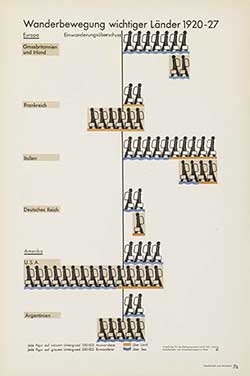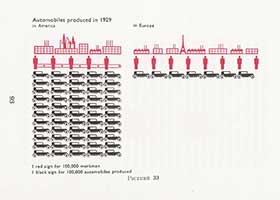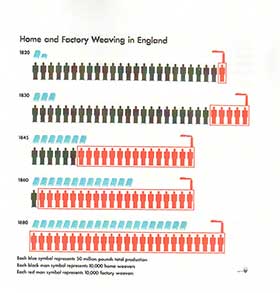
Logical Empiricism and Knowledge
Visualisation: Isotype as a Universal
Language for Social Statistics
- Başak Aray
_______________________________

Fig. 7. O. Neurath, Gesellschaft und
Wirtschaft, 1930. Migration Chart. 

Fig. 8. O. Neurath, International Picture
Language, 1936. Automobile Production 

Fig. 9. O. Neurath, Modern Man in the Making, 1939.
Home and Factory Weaving in England 
Isotype succeeds in representing complex information with minimal graphism, thanks to its virtues of reductivism and consistency. In the chart of migrations from 1920 to 1927 (fig. 7), the standard pictogram for man is drawn in profile, with the figure carrying luggage and in motion, to represent migrating masses. Series of icons moving towards the country indicated on the left side represent immigrants entering that country, and series moving to the opposite side represent emigrants from that country. The graphic element under the feet of the migrants indicates the mode of transportation: a straight line for land and a wave for sea. Migration numbers, destinations and means of transportation are thus clearly indicated with consistent variations of the basic pictogram. The chart of automobiles produced in 1929 (fig. 8) compares the automobile production in America and Europe. The line behind the American workers represents mechanized production. As usual, several types of information are present in the chart concerning numbers of workers and products, and it is possible to compare the productivity of the two methods of fabrication. For the chart of home and factory weavers in England from 1820 to 1880 (fig. 9), the same pictogram for worker is used, the factory weavers indicated by the colour red, a traditional symbol for industry, and the symbol of a factory around them. The chart contains information about quantities of production and the number of home-weavers and factory-weavers over a period of 60 years, and it allows multiple comparisons.
Another guiding principle of Isotype is conservatism, which aims to increase its intuitive effectiveness by integrating familiar elements. Current graphic conventions like direction of reading and disposition of the countries on a map are respected, as well the current semiology: a toothed wheel stands for industry; a sickle, agriculture; a hammer, handicraft; a scale, trade. Colour use conforms to established colour symbolism, like green for agriculture or youth, grey for indeterminate or unorganized, red for socialism, trade-unions or workers.
Contacts with International Auxiliary Languages
Neurath's search for an intercultural medium for universal communication fits into the framework of the international auxiliary language (IAL) movement of his time. What he did for information design was also the subject of many constructive projects by interlinguists, who attempted to solve the problem of international communication in a globalizing world. Inspired mainly by humanist ideals of pacifism and equality, those linguistic projects privileged the use of common elements, at the expense of specific local expressions, simplicity in word construction, as well as minimalism and regularity in grammar to ensure ease of learning. The most emblematic and arguably the most successful of IALs to date, Esperanto has a major place amongst Neurath's inspirations for a universal visual language (which he referred to as a “pictorial Esperanto”). Although not conceived as an independent linguistic medium like these IALs, Isotype shares their motivation and general principles. An examination of two IALs related to Neurath's own work (Basic English and Interglossa) can show the affinities of his empiricist philosophy of language with the IAL movement.
Basic English
Despite having been conceived for a different purpose, Charles K. Ogden's Basic English uses a pattern similar to Neurath's. Basic is a condensed version of Standard English with a reduced vocabulary of 850 words. This reductive mechanism of translating into Basic English by decomposition to chosen basic concepts reflects Ogden's empiricist ideal of language as a transparent medium expressing the empirical origin of abstract concepts [4]. Ogden calls this process “vertical translation,” i.e. translation inside the same language into a smaller set of words. It is characterized by the elimination of verbs, replaced by an operator corresponding to a basic operational concept, possibly combined with a directive corresponding to a basic direction-word. There are 11 operators (do, make, take, give, put, have, keep, let, make, be, seem) and 20 directives (through, from, to, over, under, by, at, against, up, down, about, among, across, on, off, after, before, between, within, out) in total, with which Basic renders almost all the verbs of standard English (to disembark will be translated as to get off a ship; to insert as to put in; to pass as to go by; to climb as to go over; to break a rule as to go against a rule). Finally, irregularities in matters of spelling or conjugation are minimized in order to avoid unnecessary complications for beginners.
The reductive system of Basic English develops from Ogden's emphasis on empirical reduction for clarity and improved communication. Strongly influenced by the empiricist tradition, Ogden's philosophy of language plays a similar role to Neurath's physicalism in the conception of Isotype. As an inheritor of British empiricism, Ogden stressed the physicalist origins of abstract concepts and stated that abstraction develops metaphorically from concrete expressions relating to physical bodies, along the same vein as in Locke and Bentham. Another influence for Basic English was Bridgman's operationalism, according to which Ogden defined verbs primarily as physical operations in space. Hence the critical function of Basic English for native English speakers: vertical translation becomes reduction to empirical origins, which results in the deconstruction of linguistic fictions [5]. The anti-metaphysical effect of eliminating misleading expressions is also an important motivation for Neurath in privileging visualization over verbal education [6]. The limits of the pictorial medium impose an empirical reduction, eliminating beforehand possible metaphysical developments. Value judgements, private experience, supernatural or religious beliefs cannot be expressed in a visual language – which makes visual language neutral compared to verbal language. By excluding such idiomatic expressions that divide people and hamper communication, visual language becomes a democratic medium for argumentation and education.
[4] “For the modern scientist and technologist, no less than Bergson or the man in the street, language is first and foremost an apparatus for dealing with things in space. What is ‘there’ to be talked about is primarily a nexus of individual bodies; and only through metaphor do we seem to be talking about other sorts of entities. All such metaphorical and fictional jargon is capable of translation, and for technological purposes must be translated, into something less deceptive” (Ogden 1936, pp. 192-3).
[5] “If, as we maintain, manipulation of the minimum vocabulary gives practice in the analytic habit of mind which is essential to scientific thinking, and if the Basic words point to the concrete constituents of those fictional statements by which the sophisticated no less than the untutored mind is so frequently misled, its relevance at every phase of the educational curriculum cannot be questioned” (Ogden 1936, pp. 214-5).
[6] “Starting with ‘icons’ implies far-reaching limitations of language, but these limitations sometimes eliminate much danger. We are, e. g., not able to create an analogy to ‘a through is walking through a through’ in our picture language” (Neurath 1941a, p. 218).


